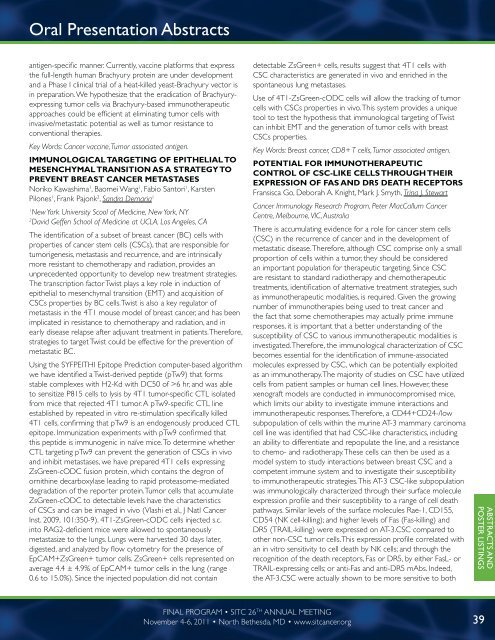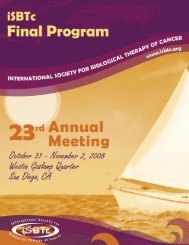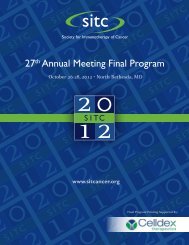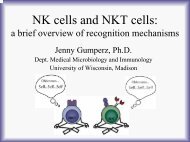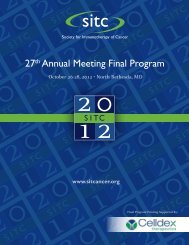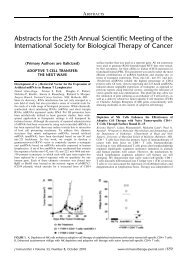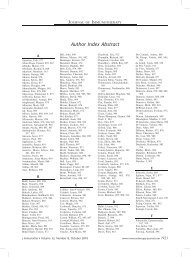FINAL PROGRAM - Society for Immunotherapy of Cancer
FINAL PROGRAM - Society for Immunotherapy of Cancer
FINAL PROGRAM - Society for Immunotherapy of Cancer
Create successful ePaper yourself
Turn your PDF publications into a flip-book with our unique Google optimized e-Paper software.
Oral Presentation Abstracts<br />
antigen-specific manner. Currently, vaccine plat<strong>for</strong>ms that express<br />
the full-length human Brachyury protein are under development<br />
and a Phase I clinical trial <strong>of</strong> a heat-killed yeast-Brachyury vector is<br />
in preparation. We hypothesize that the eradication <strong>of</strong> Brachyuryexpressing<br />
tumor cells via Brachyury-based immunotherapeutic<br />
approaches could be efficient at eliminating tumor cells with<br />
invasive/metastatic potential as well as tumor resistance to<br />
conventional therapies.<br />
Key Words: <strong>Cancer</strong> vaccine, Tumor associated antigen.<br />
IMMUNOLOGICALTARGETING OF EPITHELIALTO<br />
MESENCHYMALTRANSITION AS A STRATEGYTO<br />
PREVENT BREAST CANCER METASTASES<br />
Noriko Kawashima 1 , Baomei Wang 1 , Fabio Santori 1 , Karsten<br />
Pilones 1 , Frank Pajonk 2 , Sandra Demaria 1<br />
1<br />
New York University Scool <strong>of</strong> Medicine, New York, NY<br />
2<br />
David Geffen School <strong>of</strong> Medicine at UCLA, Los Angeles, CA<br />
The identification <strong>of</strong> a subset <strong>of</strong> breast cancer (BC) cells with<br />
properties <strong>of</strong> cancer stem cells (CSCs), that are responsible <strong>for</strong><br />
tumorigenesis, metastasis and recurrence, and are intrinsically<br />
more resistant to chemotherapy and radiation, provides an<br />
unprecedented opportunity to develop new treatment strategies.<br />
The transcription factor Twist plays a key role in induction <strong>of</strong><br />
epithelial to mesenchymal transition (EMT) and acquisition <strong>of</strong><br />
CSCs properties by BC cells. Twist is also a key regulator <strong>of</strong><br />
metastasis in the 4T1 mouse model <strong>of</strong> breast cancer, and has been<br />
implicated in resistance to chemotherapy and radiation, and in<br />
early disease relapse after adjuvant treatment in patients. There<strong>for</strong>e,<br />
strategies to target Twist could be effective <strong>for</strong> the prevention <strong>of</strong><br />
metastatic BC.<br />
Using the SYFPEITHI Epitope Prediction computer-based algorithm<br />
we have identified a Twist-derived peptide (pTw9) that <strong>for</strong>ms<br />
stable complexes with H2-Kd with DC50 <strong>of</strong> >6 hr, and was able<br />
to sensitize P815 cells to lysis by 4T1 tumor-specific CTL isolated<br />
from mice that rejected 4T1 tumor. A pTw9-specific CTL line<br />
established by repeated in vitro re-stimulation specifically killed<br />
4T1 cells, confirming that pTw9 is an endogenously produced CTL<br />
epitope. Immunization experiments with pTw9 confirmed that<br />
this peptide is immunogenic in naïve mice. To determine whether<br />
CTL targeting pTw9 can prevent the generation <strong>of</strong> CSCs in vivo<br />
and inhibit metastases, we have prepared 4T1 cells expressing<br />
ZsGreen-cODC fusion protein, which contains the degron <strong>of</strong><br />
ornithine decarboxylase leading to rapid proteasome-mediated<br />
degradation <strong>of</strong> the reporter protein. Tumor cells that accumulate<br />
ZsGreen-cODC to detectable levels have the characteristics<br />
<strong>of</strong> CSCs and can be imaged in vivo (Vlashi et al., J Natl <strong>Cancer</strong><br />
Inst. 2009, 101:350-9). 4T1-ZsGreen-cODC cells injected s.c.<br />
into RAG2-deficient mice were allowed to spontaneously<br />
metastasize to the lungs. Lungs were harvested 30 days later,<br />
digested, and analyzed by flow cytometry <strong>for</strong> the presence <strong>of</strong><br />
EpCAM+ZsGreen+ tumor cells. ZsGreen+ cells represented on<br />
average 4.4 ± 4.9% <strong>of</strong> EpCAM+ tumor cells in the lung (range<br />
0.6 to 15.0%). Since the injected population did not contain<br />
detectable ZsGreen+ cells, results suggest that 4T1 cells with<br />
CSC characteristics are generated in vivo and enriched in the<br />
spontaneous lung metastases.<br />
Use <strong>of</strong> 4T1-ZsGreen-cODC cells will allow the tracking <strong>of</strong> tumor<br />
cells with CSCs properties in vivo. This system provides a unique<br />
tool to test the hypothesis that immunological targeting <strong>of</strong> Twist<br />
can inhibit EMT and the generation <strong>of</strong> tumor cells with breast<br />
CSCs properties.<br />
Key Words: Breast cancer, CD8+ T cells, Tumor associated antigen.<br />
POTENTIAL FOR IMMUNOTHERAPEUTIC<br />
CONTROL OF CSC-LIKE CELLS THROUGH THEIR<br />
EXPRESSION OF FAS AND DR5 DEATH RECEPTORS<br />
Fransisca Go, Deborah A. Knight, Mark J. Smyth, Trina J. Stewart<br />
<strong>Cancer</strong> Immunology Research Program, Peter MacCallum <strong>Cancer</strong><br />
Centre, Melbourne, VIC, Australia<br />
There is accumulating evidence <strong>for</strong> a role <strong>for</strong> cancer stem cells<br />
(CSC) in the recurrence <strong>of</strong> cancer and in the development <strong>of</strong><br />
metastatic disease. There<strong>for</strong>e, although CSC comprise only a small<br />
proportion <strong>of</strong> cells within a tumor, they should be considered<br />
an important population <strong>for</strong> therapeutic targeting. Since CSC<br />
are resistant to standard radiotherapy and chemotherapeutic<br />
treatments, identification <strong>of</strong> alternative treatment strategies, such<br />
as immunotherapeutic modalities, is required. Given the growing<br />
number <strong>of</strong> immunotherapies being used to treat cancer and<br />
the fact that some chemotherapies may actually prime immune<br />
responses, it is important that a better understanding <strong>of</strong> the<br />
susceptibility <strong>of</strong> CSC to various immunotherapeutic modalities is<br />
investigated. There<strong>for</strong>e, the immunological characterization <strong>of</strong> CSC<br />
becomes essential <strong>for</strong> the identification <strong>of</strong> immune-associated<br />
molecules expressed by CSC, which can be potentially exploited<br />
as an immunotherapy. The majority <strong>of</strong> studies on CSC have utilized<br />
cells from patient samples or human cell lines. However, these<br />
xenograft models are conducted in immunocompromised mice,<br />
which limits our ability to investigate immune interactions and<br />
immunotherapeutic responses. There<strong>for</strong>e, a CD44+CD24-/low<br />
subpopulation <strong>of</strong> cells within the murine AT-3 mammary carcinoma<br />
cell line was identified that had CSC-like characteristics, including<br />
an ability to differentiate and repopulate the line, and a resistance<br />
to chemo- and radiotherapy. These cells can then be used as a<br />
model system to study interactions between breast CSC and a<br />
competent immune system and to investigate their susceptibility<br />
to immunotherapeutic strategies. This AT-3 CSC-like subpopulation<br />
was immunologically characterized through their surface molecule<br />
expression pr<strong>of</strong>ile and their susceptibility to a range <strong>of</strong> cell death<br />
pathways. Similar levels <strong>of</strong> the surface molecules Rae-1, CD155,<br />
CD54 (NK cell-killing); and higher levels <strong>of</strong> Fas (Fas-killing) and<br />
DR5 (TRAIL-killing) were expressed on AT-3.CSC compared to<br />
other non-CSC tumor cells. This expression pr<strong>of</strong>ile correlated with<br />
an in vitro sensitivity to cell death by NK cells; and through the<br />
recognition <strong>of</strong> the death receptors, Fas or DR5, by either FasL- or<br />
TRAIL-expressing cells; or anti-Fas and anti-DR5 mAbs. Indeed,<br />
the AT-3.CSC were actually shown to be more sensitive to both<br />
ABSTRACTS AND<br />
POSTER LISTINGS<br />
<strong>FINAL</strong> <strong>PROGRAM</strong> • SITC 26 TH ANNUAL MEETING<br />
November 4-6, 2011 • North Bethesda, MD • www.sitcancer.org<br />
39


